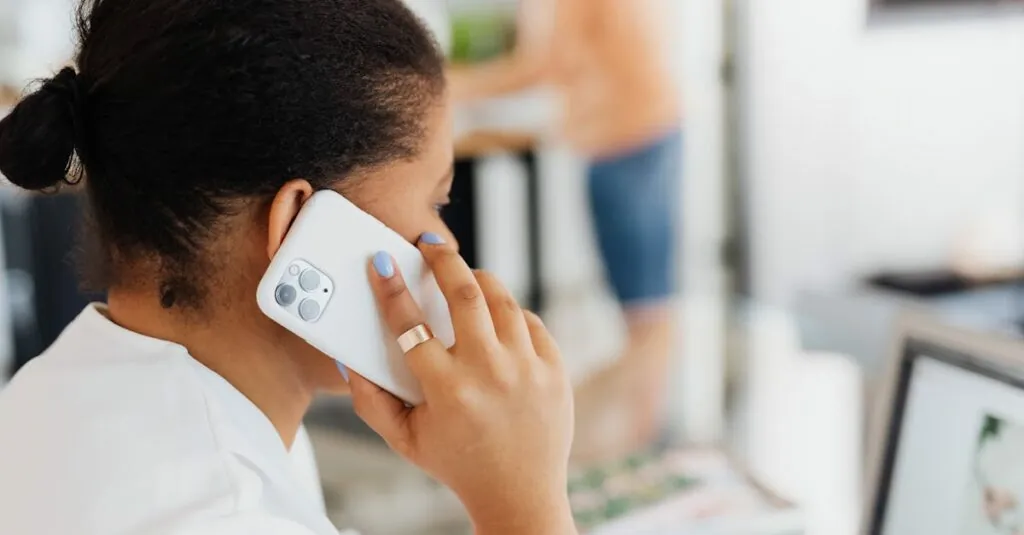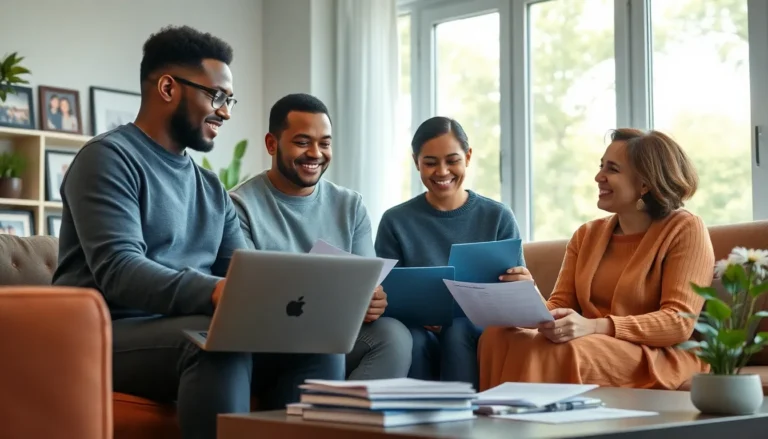Table of Contents
ToggleCapturing that perfect moment on your iPhone 14 has never been easier—or more entertaining. Whether it’s a hilarious meme, a must-share text, or an epic game score, knowing how to screenshot can save the day. But if you’re still fumbling around trying to remember the button combo, don’t worry—you’re not alone.
Overview of Screenshotting on iPhone 14
Screenshotting on the iPhone 14 offers users a simple way to save and share important information. The process relies on a straightforward button combination: pressing the Side button and the Volume Up button simultaneously captures the current screen. This method applies to various apps and content displayed on the device.
After taking a screenshot, a visual thumbnail appears in the bottom left corner, allowing immediate access to editing and sharing options. Tapping the thumbnail opens an editing interface where users can annotate, crop, or share the screenshot directly via messaging or social media.
Discovering different applications for screenshots broadens their usefulness. Users can save important conversations, preserve gaming achievements, or compile images for creative projects. Flexibility in usage enhances the value of screenshotting within the iPhone environment.
Settings within the Photos app allow for easy organization and management of screenshots. Users can find captured images in the “Screenshots” album, making retrieval straightforward and efficient. This dedicated album ensures that all screenshots are systematically categorized, promoting a tidy photo library.
Mastering the screenshot function on iPhone 14 adds convenience to daily tasks. Users can quickly respond to messages with captured texts or store visuals for later reference. Embracing this feature elevates the iPhone experience, making it an indispensable tool for functionality.
Methods to Screenshot on iPhone 14
Several methods exist for taking screenshots on the iPhone 14, accommodating users’ preferences and needs.
Using Physical Buttons
Pressing the Side button along with the Volume Up button captures the screen instantly. It’s essential to ensure both buttons are pressed simultaneously for the best results. A thumbnail will appear in the lower left corner after the screenshot, allowing for quick edits or sharing. Tapping the thumbnail opens editing options, where users can crop, annotate, or delete their screenshots as desired. This method proves effective for quickly capturing conversations, images, or game scores.
Using AssistiveTouch
AssistiveTouch simplifies the screenshot process for those who prefer not to use physical buttons. Activating AssistiveTouch enables a floating menu on the screen. Users can customize this menu to include the screenshot option for easy access. Tapping on the AssistiveTouch icon followed by the Screenshot option takes a screenshot just like using the physical buttons. This feature enhances accessibility, especially for users with mobility challenges. It provides a seamless experience for capturing important information and moments.
Tips for Taking Effective Screenshots
Capturing screenshots on the iPhone 14 is easy, but knowing how to make them effective enhances their utility. Users can follow a few tips to improve their screenshot game.
Editing Screenshots
Screenshots offer immediate access to editing tools right after capture. Users can tap the thumbnail to open an editing interface. Cropping allows for focused content, while annotations highlight specific details. Adding text or drawings can provide context or emphasize important points. Utilizing the color and size options for markup makes enhancements visually clear. After making adjustments, saving the edited version secures the changes.
Sharing Screenshots
Sharing screenshots is straightforward on the iPhone 14. Users can select the share icon on the editing screen to access various options. Options include sending via messaging apps, posting to social media, or sharing via email. Direct sending enhances convenience, especially for quick exchanges of information. Users can also save screenshots to cloud storage services, ensuring easy access across devices. A well-organized sharing strategy aids in effective communication and information dissemination.
Common Issues with Screenshots
Users may encounter specific issues when taking screenshots on the iPhone 14. One frequent problem involves the screenshot not capturing the intended content. This often occurs due to pressing the buttons incorrectly or too late.
Another issue arises with the quality of screenshots. Occasional blurriness or pixelation might result from capturing content displayed with low resolution. It’s essential to check the source’s resolution when needing clear images.
Some users find that screenshots do not save in the Photos app. This situation can happen if the user runs low on storage space or if there are glitches in the device’s software. Regularly checking storage and keeping the iPhone’s software updated helps prevent this problem.
Errors can also occur when attempting to edit screenshots. In some instances, the editing options might not be available immediately after taking the screenshot. Restarting the device or refreshing the Photos app often resolves this issue.
Anti-spam features in messaging platforms may block screenshots when sharing directly. When trying to send a screenshot via text or social media, it’s wise to check the platform’s policies on shared content.
Lastly, screenshots may contain unwanted content such as notifications or app icons. To ensure a cleaner look, users should consider cropping images before sharing. Understanding these common issues enhances the screenshot experience on the iPhone 14, making it easier to capture and share important moments effectively.
Capturing and sharing moments on the iPhone 14 is now easier than ever. By mastering the screenshot function users can enhance their communication and creativity. Whether it’s preserving a memorable conversation or showcasing a gaming achievement the ability to take screenshots adds significant value to the iPhone experience.
With various methods available including the physical buttons and AssistiveTouch users can choose what works best for them. The editing features further empower users to customize their screenshots, ensuring they convey the right message.
By understanding common challenges and utilizing the tips provided users can make the most of this handy feature. Embracing the screenshot function truly transforms how users interact with their devices and the world around them.







